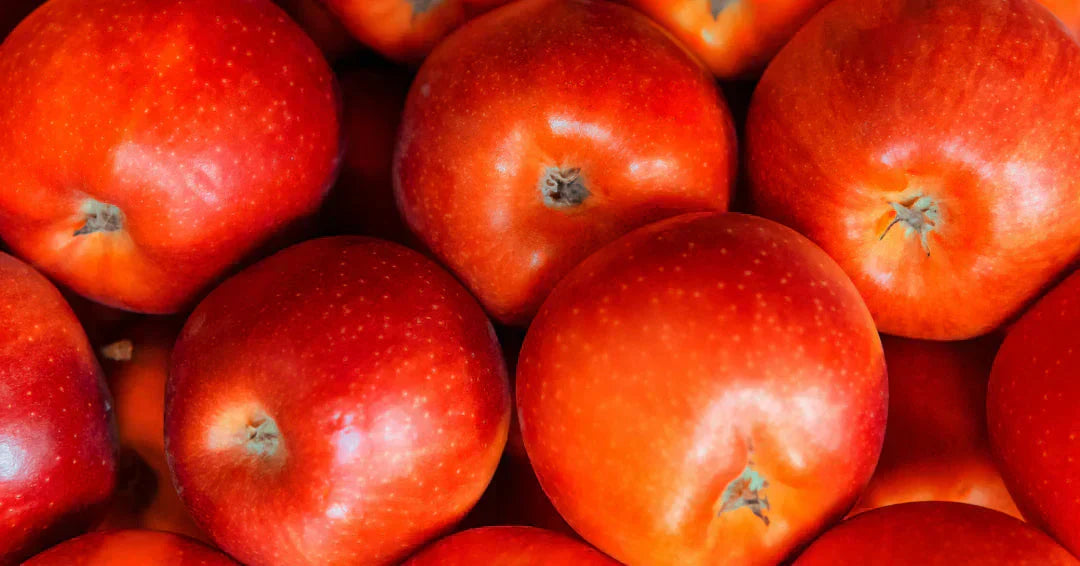There is so much to learn about this delicious fruit, like how apple farmers take care of their trees, numerous varieties, how many are consumed every year, mouthwatering recipes , and so much more! Kids hungry to learn more about the nutritional value every time they take a bite will find these apple facts for very satisfying.

Everything to Know About Apples
Reading children's books about apples is a fantastic way to share all the healthy benefits, delicious recipes, and funny stories about characters who can't get enough of this yummy fruit. Readers will learn about how many years it takes for farmers to grow them, the many varieties that exist beyond what they see on the store shelves, and so much more. With so many different flavors, ranging from sugary sweet to extremely sour, it is so much fun to compare and contrast them all. Children will love exploring all the different colors and consistency of the fruit. Here is some fascinating information about apples to share with your kids to encourage them to put down a bag of chips and pick up a crunchy, healthy piece of fruit instead.
Fun Apple Trivia Children Will Love to Learn
Apple trivia is a hit with kids because it masterfully combines fun with facts. Children are naturally drawn to learning about apples since the fruit is so familiar and accessible. The information isn't abstract or boring; it connects directly to hands-on, enjoyable experiences like apple picking and bobbing for apples. For instance, the simple fact that apples float because they're 25% air transforms a simple fall game into a neat, memorable science lesson.

Beyond the playful connection, the topic also offers genuinely impressive knowledge. Kids are often captivated by mind-blowing numbers like the existence of over 7,500 apple varieties globally or the statistic that it takes about 36 apples to make a gallon of cider, which builds real-world math connections. Finally, learning about an apple's fiber and vitamins reinforces healthy eating in an engaging way, supporting the popular idea that apples are good for the brain and memory. Ultimately, apple trivia transforms a common snack into a surprising source of science, history, and math.

(1) Despite modern technology, most apples are still hand-picked.
So give the apple farmers a hand this fall and go on an apple-picking outing with your whole family! Despite the advancement in modern technology, machines designed to pick fruit from trees are too rough, leaving apples bruised and unfit for sale in the markets. Seasonal workers are hired to pluck them by hand, after which they are placed in bins and then transported by forklift to the packing area.
(2) Apples float because 25 percent of their volume is air.
Bobbing for apples at Halloween would never be possible if the fruit had a different composition. But because they are less dense than water, despite the skin, seed, and juice, they never sink when placed in water. The porous, relatively dry flesh is the perfect environment to trap air, which represents about a quarter of its volume, thus allowing them to float while other similar-sized objects sink to the bottom.

(3) A whopping 36 apples is required to make just one gallon of apple cider.
Every fall, grocery stores and farmers markets stock shelves with delicious apple cider. Ever wonder why apple cider is so expensive? Shoppers eager to bring home this tasty, seasonal beverage may opt to pass adding it to their carts due to sticker shock. A single gallon can range anywhere from $10 to $30 depending on the brand. However, if you understand that it takes about 20 pounds of apples for a gallon of apple cider, the price tag doesn't seem quite as absurd. The ingredients and labor involved in delivering this seasonal beverage are the driving force behind the high cost, and the reason why it is only sold during the autumn months.
(4) Apple cider is expensive for several reasons.
Every gallon requires 36 to 42 apples, and prices are going up due to lower production. Apple farmers are on the decline due to higher costs associated with machinery, pesticides, and fertilizer. Furthermore, labor costs are also on the rise which are also driving up the price for a gallon of apple cider. Keep this in mind if you ever decide to try a homemade recipe. In addition to a huge apple supply, you will need some sugar, cinnamon, and allspice to make a deliciously sweet cider.

(5) An apple tree does not produce fruit until 8-10 years after it has been planted.
Patience is definitely a virtue if you want to grow a brand new tree that bears delicious fruit in your own backyard. Standard trees that grow to about 30 feet tall take almost a decade to bear fruit. For people who want to harvest them their backyard, dwarf trees are the way to go. They take up far less space and start producing fruit in as little as two to three years after planting.
(6) Apples are part of the rose family.
Some theories suggest that apples originated from roses due to a change in climate or some catastrophic environmental occurrence at least 40 million years ago. The Rosaceae family includes a whole host of fruits including plums, blackberries, raspberries, strawberries, peaches, pears, and cherries. A defining composition of these fruits consists of a core of seeds surrounded by a tough membrane. Next time you see an apple blossom, take note of the similarities it shares with a wild rose.
(7) Although 2,500 apple varieties are grown in the US, only 100 apple types are for commercial sale.
Even so, this is still too a high variety for grocery stores to carry. Some of the most common apples found on store shelves include Red Delicious, Fuji, McIntosh, Pink Lady, Honeycrisp, Golden Delicious, Granny Smith, and Gala. Worldwide, there are approximately 7,500 different types of produced in various climates and for different purposes. Most of these apples are considered edible, although many are too tart or sour for most palates, making them better suited for baking.

(8) Apples are an incredible source of fiber.
In fact, a large apple contains about 5 grams, which is 17% of the daily recommended amount. A type of soluble fiber in apples, called pectin, is an important source of nourishment for friendly gut bacteria. Fiber is also beneficial in that it provides a sense of fullness, facilitates weight loss, lower blood sugar levels, and improves digestion.
(9) Apples are healthy for the heart.
Cardiologists recommend that their patients add them to their regular diet for a number of scientifically proven reasons. In fact, studies have shown that people who eat more are less likely to ever have to step foot in the office due to their lower risk of developing heart disease. The primary source of fiber, called pectin, binds to cholesterol that forms in the digestive tract and escorts it out of the body. Also, data supports that eating a single apple a day can reduce blood pressure and inflammation in the body.
(10) In George Washington's spare time, he was known to prune his apple trees.
Kids may be more familiar with the legend of George Washington cutting down the cherry tree. But, more importantly, he was famous for growing trees on his Mount Vernon estate and other properties around the country. The Yellow Newton Pippin, also called the Albemarle Pippin, was apparently his favorite apple variety. During the colonial period, the demand for apples was driven by cider production.

(11) Apples are a common food allergen.
In fact, about 5% -8% of children are allergic to the protein in this fruit. Symptoms range from mild to severe and include, itchiness, hives, swelling of the tongue and mouth, abdominal pain, nausea, vomiting, wheezing, shortness of breath, and in the most extreme cases, a life threatening condition called anaphylaxis. The best children's books about food allergies are valuable resources for kids who have food sensitivities and severe allergies, and teach them what they need to do if they experience any of these dangerous symptoms. Just a single bite can wreak havoc on the body of child with a severe allergy.
(11) The Black Diamond is the rarest of all.
You will definitely not find this type at your local grocery store. Travel to Asia where this Chinese Red Delicious variety is sold at markets across the continent. But be prepared to open your wallet as a single apple can cost upward of $8. With a dark purple skin and white flesh, one can expect a crunchy, sweet experience biting into this rarity. The trees, which take 8 years to mature, grow in the high-altitude mountains of Tibet and produce fruit for a short couple of months each year.

More Fun Food Facts for Kids
Children naturally enjoy learning surprising trivia about food because it perfectly aligns with their developmental psychology and innate curiosity. This is due to the power of novelty: facts that are unexpected or counter-intuitive—like discovering a banana is botanically a berry or that carrots were once purple—instantly captivate a child's attention. By challenging what they thought they knew, this novelty makes the information highly memorable and exciting. Furthermore, a fun fact acts as a spark for deeper inquiry. For instance, learning that an apple is mostly air or that it belongs to the rose family encourages them to immediately ask "Why?" and "How?", effectively turning the dinner table into a laboratory for critical thinking and scientific exploration.






